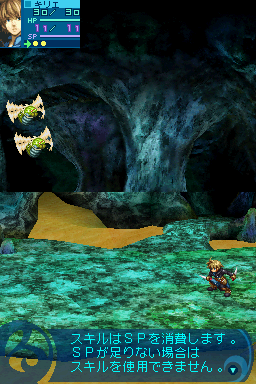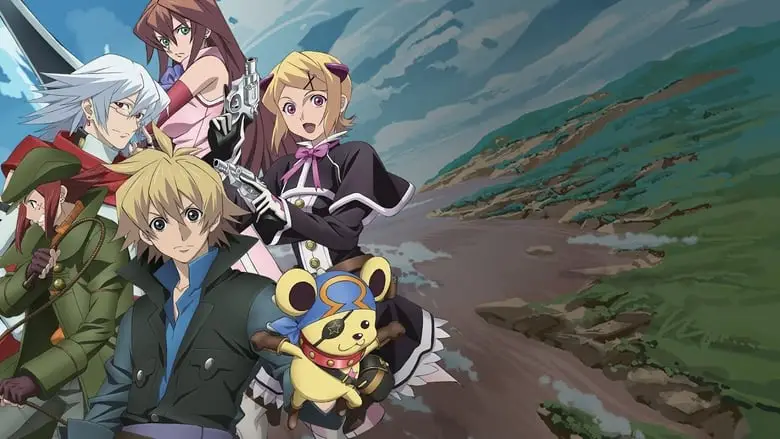Note: Because of dual screen capture, the screenshots of DS will remain in their regular resolution and centered accordingly. Thus they may appear condensed or small but I did not want to stretch them out.
The game World Destruction – Michibikareshi Ishi (meaning roughly “guided will”) is kind of a part of a whole as there was a Japanese animation series, a manga series, and even an internet radio series comprising the story before it was even released. The story is kind of somewhat complex and you may need to engage in the other media the series has to offer to better understand everything that is going on and who everyone is. Think of the game as a compliment to the series.
Developed by Imageepoch and published by Sega, World Destruction – Michibikareshi Ishi was released for the Nintendo DS on September 25, 2008 in Japan. It was subsequently released for the west on January 12, 2010 where the title was localized as Sands of Destruction. I will be reviewing the Japanese release of the game. As far as I know there isn’t any major differences between the two version besides voices and the localized name change of the game title.
The story’s beginning for the end of the world
In the world that takes place in World Destruction, humans are second-rate beings to humanoid-like beasts known as Ferals. Their status is that where slavery is not uncommon. Interestingly enough, the game writer for the game Masato Kato, had a much more darker view on the story. Instead of being slave-like, humans were intended to be food for the Ferals with him intending to show humans being eaten in the game. To appeal to a broader audience and avoid a stricter CERO rating (Japan’s version of ESRB), they removed that aspect. I found it would have been more compelling personally but opinions vary. Nevertheless, Morte, whose name originates from Portugese and Italian meaning “death,” views world destruction as a means to end the subjugation of humans and seeks companions to do so.
The hero’s home is always peaceful at the beginning of my RPGs although later on can be a different story.

This is Kyrie’s home village of Barni. Kyrie, whose name originates from the Greek word “Κύριε,” which means “Lord” is the male protagonist of World Destruction. He is mild-mannered and and tends to be very reserved. He holds a very special power that is latent in him and unbeknownst to himself in which he is able to destroy the world.
By land or air dual screen duels— a battle system with a slight learning curve

[Skills consume skill points. If you do not have enough skill points, then you can not use skills.] Battles can be fought on ground as well as in the air which optimizes the dual screen of the Nintendo DS and gives each battle a grander scale feel especially when there are bosses that take up both screens.
Battle basics of World Destruction: In World Destruction, battles are fought via random battles and up to three characters can participate in battle while the up to other three remain in reserve. It is a standard JRPG battle system where each enemy and character takes turns fighting. After battles, you gain experience points, customize points, and money. Customize points or CP can be used to strengthen each characters’ attacks. Random battle encounter rate can seem high in some areas although again opinions vary.
Battle points: Battle points are the amount of actions a character has per turn. You can get more battle points via battle by inflicting a critical hit, inflicting a status ailment on an enemy, or by getting a ten-hit combo.
Morale: The arrow in the screenshot above indicates morale. Morale can be either low, normal, or high. A gray arrow pointing down indicates low morale, a green arrow pointing sideways indicates normal morale, and a red arrow pointing up indicates high morale. Morale indicates how many battle points you start with ranging from one to three. Equipping an accessory with a broken heart will lead to low morale, while equipping one without a heart will lead to normal morale, and equipping an accessory with a full heart will lead to high morale. Morale doesn’t change instantly and requires several battles for it to adjust.
Attacks: There are two main type of attacks in World Destruction—flurry attacks and blow attacks. Flurry attacks are weaker but more in number with a better chance to combo. Blow attacks are stronger but fewer in number.
Defend: Reduces damage.
Abilities / Skills: Special attacks that can either deal damage, inflict a status ailment, cure, revive, etc. and cost a certain amount of skill points to use.
Special attacks: An attack that is released after performing a certain amount of combo hits that requires button input to inflict the full amount of damage.
The meaner the mugshot, usually the greater the reward

[Wanted: The Crimson Morte] Throughout the game, the characters in your party will be wanted for wanting to destroy the world and being members of the World Annihilation Front. As you progress in the game, the art on the wanted posters for the game will change and so will the wanted amounts. Above is a slightly egregious as well as slightly comical portrayal of Morte. The wanted posters amount sometimes needs to be above a certain level before some events will be flagged.

[Hey, what are you doing? Hurry up and exterminate them!] Morte is very much a strong-willed female lead who kind of balances out the male lead Kyrie’s timidness. She is the leader of the World Annihilation Front but Kyrie is key to fulfilling her plans of world destruction.
[I am done for in a place like this…] The floating prison is a place that you will visit a couple times. Even with the map on the top screen, it can be kind of confusing. The last time you are there, there are a few missable things including a exhausting quest that you need to talk to several people in order to complete.







